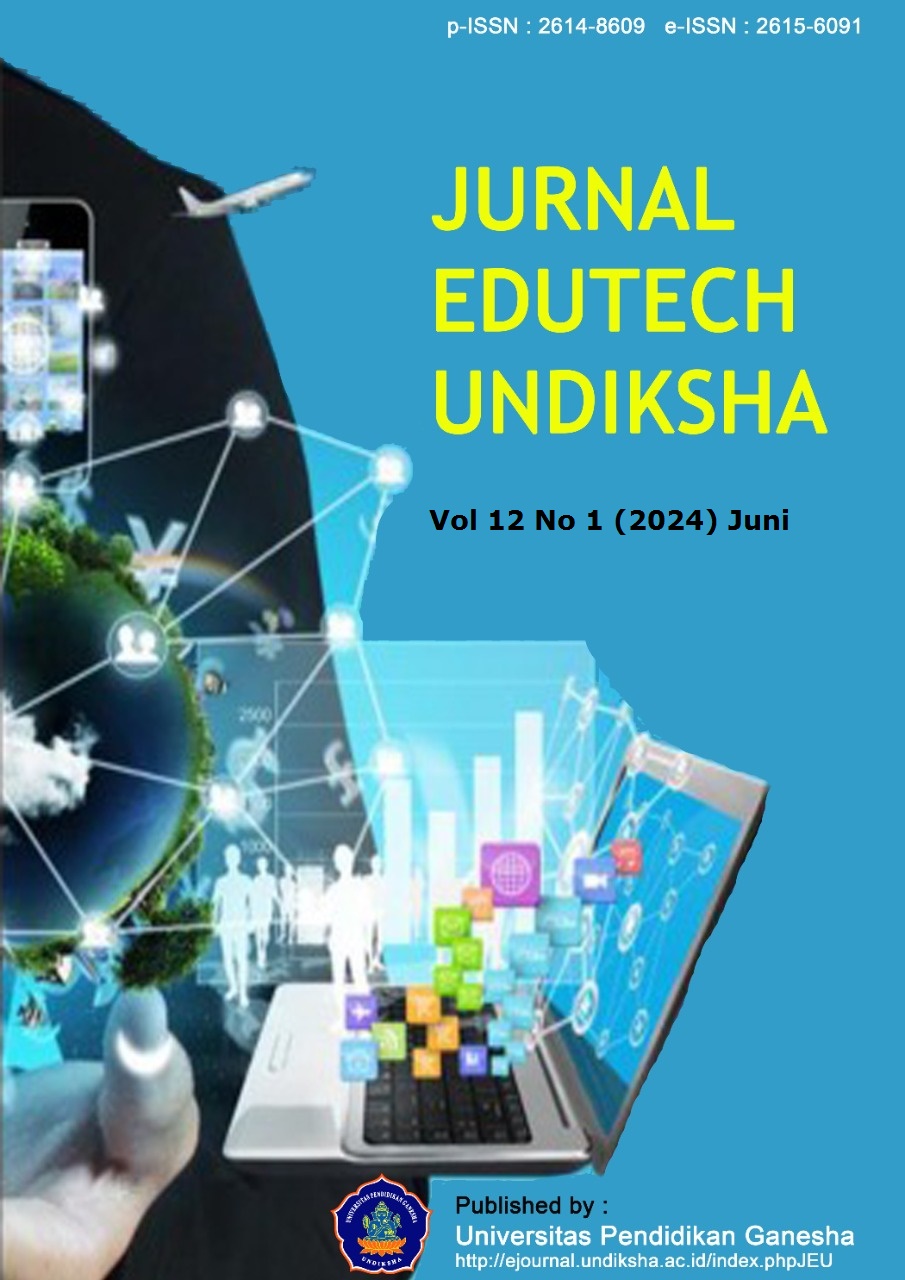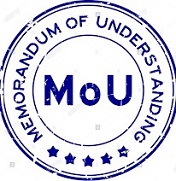Android-Based Interactive Learning Multimedia to Improve Reading Literacy in High Schools
DOI:
https://doi.org/10.23887/jeu.v12i1.64482Keywords:
Learning Multimedia, Dick & Carey, Reading LiteracyAbstract
Reading is the first skill to master in other literature. Students’ literacy is still low, according to PISA in 2018. There is a need for efforts to improve literacy skills, one of which is the development of literacy platforms. The aim of this research is to develop multimedia learning to improve reading literacy. Research and development (R&D) is based on the Dick & Carey development model. The study was conducted at senior high school, with 30 students participating. Multimedia is validated by material, design, and media experts. Data from the questionnaire instruments and student responses are analyzed with both qualitative and quantitative analysis. Overall, from the data analysis results, expert validation data was declared "very valid" with an average of 4.27. The results of an empirical test analysis with individual, small-group, and field trials stated the media was "very valid" and ready for use in learning, with an average of 4.66. From the results of the pretest and posttest involving 30 students, the result of the calculation of the t test obtained a value of 0,000, with the conclusion that there was a difference in the outcome of the pre-test and post-test. From the calculation of effect size with Cohen’s d, we get a value of 3.55 for category strong. Based on the results above, the Literacy Platform application developed can improve reading literacy and can be applied to learning.
References
Aka, K. A. (2017). Pemanfaatan Teknologi Informasi dan Komunikasi (TIK) sebagai Wujud Inovasi Sumber Belajar di Sekolah Dasar. ELSE (Elementary School Education Journal): Jurnal Pendidikan Dan Pembelajaran Sekolah Dasar, 1, 28–37. https://doi.org/10.30651/else.v1i2a.1041.
Arif, A., & Mukhaiyar, R. (2020). Pengembangan Multimedia Interaktif pada Mata Pelajaran Dasar Listrik dan Elektronika Kelas X Teknik Instalasi Tenaga Listrik di SMK Muhammadiyah 1 Padang. Jurnal Teknik Elektonik Dan Vokasional, 06(01), 114–119. https://doi.org/10.24036/jtev.v6i1.107717. DOI: https://doi.org/10.24036/jtev.v6i1.107717
Arini, A., & Umami, H. (2019). Pengembangan Pembelajaran Pendidikan Agama Islam Melalui Pembelajaran Konstruktivistik Dan Sosiokultural. Indonesian Journal of Islamic Education Studies (IJIES), 2(1), 104–114. https://doi.org/10.33367/ijies.v2i2.845. DOI: https://doi.org/10.33367/ijies.v2i2.845
Chairunnisa Amelia, & Pratiwi, I. (2020). PKM Pojok Baca Untuk Meningkatkan Literasi Siswa Di UPT Sekolah Dasar. Ihsan: Jurnal Pengabdian Masyarakat, 2(2), 146–151. https://doi.org/10.30596/ihsan.v2i2.5328. DOI: https://doi.org/10.30596/ihsan.v2i2.5328
Cholifah, T. N., & Muslihasari, A. (2022). Pengembangan Digital Flipbook berbasis Dolanan Lokal untuk Meningkatkan Literasi Membaca Siswa SD di Desa Palaan pada Era Covid-19. Jurnal Bidang Pendidikan Dasar, 6(2), 149–158. https://doi.org/10.21067/jbpd.v6i2.6843. DOI: https://doi.org/10.21067/jbpd.v6i2.6843
Dere, Z. (2019). Analyzing the Early Literacy Skills and Visual Motor Integration Levels of Kindergarten Students. Journal of Education and Learning, 8(2), 176. https://doi.org/10.5539/jel.v8n2p176. DOI: https://doi.org/10.5539/jel.v8n2p176
Dick, W., & Carey, L. (2019). The Dick and Carey Model. http://www.nwlink.com/~donclark/history_isd/carey.html.
Dwiqi, G. C. S., Sudatha, I. G. W., & Sukmana, A. I. W. I. Y. (2020). Pengembangan Multimedia Pembelajaran Interaktif Mata Pelajaran IPA Untuk Siswa SD Kelas V. Jurnal Edutech Undiksha, 8(2), 33. https://doi.org/10.23887/jeu.v8i2.28934. DOI: https://doi.org/10.23887/jeu.v8i2.28934
Ernawati, I., & Sukardiyono, T. (2017). Uji Kelayakan Media Pembelajaran Interaktif Pada Mata Pelajaran Administrasi Server. Elinvo (Electronics, Informatics, and Vocational Education), 2(2), 204–210. https://doi.org/10.21831/elinvo.v2i2.17315. DOI: https://doi.org/10.21831/elinvo.v2i2.17315
Fitrianawati, M., Sintawati, M., Marsigit, & Retnowati, E. (2020). Analysis toward relationship between mathematical literacy and creative thinking abilities of students. Journal of Physics: Conference Series, 1521(3). https://doi.org/10.1088/1742-6596/1521/3/032104. DOI: https://doi.org/10.1088/1742-6596/1521/3/032104
Gogahu, D. G. S., & Prasetyo, T. (2020). Pengembangan Media Pembelajaran Berbasis E-Bookstory untuk Meningkatkan Literasi Membaca Siswa Sekolah Dasar. Jurnal Basicedu, 4(4). https://doi.org/10.31004/basicedu.v4i4.493. DOI: https://doi.org/10.31004/basicedu.v4i4.493
Harsiati, T. (2018). Karakteristik Soal Literasi Membaca Pada Program Pisa. Litera, 17(1), 90–106. https://doi.org/10.21831/ltr.v17i1.19048. DOI: https://doi.org/10.21831/ltr.v17i1.19048
Kuswanto, J. (2020). Media Pembelajaran Berbasis Android Mata Pelajaran Desain Grafis Kelas X. Edutic - Scientific Journal of Informatics Education, 6(2), 78–84. https://doi.org/10.21107/edutic.v6i2.7073. DOI: https://doi.org/10.21107/edutic.v6i2.7073
Lestari, S. (2018). Peran Teknologi Dalam Pendidikan Di Era Globalisasi. Jurnal Pendidikan Agama Islam: Edureligia, 2(2), 94–100. https://doi.org/10.33650/edureligia.v2i2.459. DOI: https://doi.org/10.33650/edureligia.v2i2.459
Mahfudh, M. R., & Imron, A. (2020). Strategi Kepala Sekolah dalam Meningkatkan Literasi Membaca Siswa di SMA Negeri 1 Kota Kediri. Indonesian Journal of Islamic Education Studies (IJIES), 3(1), 16–30. https://doi.org/10.33367/ijies.v3i1.1138. DOI: https://doi.org/10.33367/ijies.v3i1.1138
Miftah, M. (2014). Pemanfaatan Media Pembelajaran Untuk Peningkatan Kualitas Belajar Siswa. Jurnal Kwangsan, 2(1), 1. https://doi.org/10.31800/jurnalkwangsan.v2i1.11. DOI: https://doi.org/10.31800/jurnalkwangsan.v2i1.11
Mirnawati, L. B., & Fabriya, R. A. V. (2022). Penerapan Media Flipbook untuk Meningkatkan Literasi Membaca Siswa SD. Jurnal Pemikiran Dan Pengembangan Sekolah Dasar (JP2SD), 10(1), 22–38. https://doi.org/10.22219/jp2sd.v10i1.19837. DOI: https://doi.org/10.22219/jp2sd.v10i1.19837
Munir. (2015). Multimedia Konsep dan Aplikasi dalam Pendidikan. Alfabeta.
Nash, R., Otten, C., Pill, S., Williams, J., Mainsbridge, C., Cruickshank, V., & Elmer, S. (2021). School leaders reflections on their school’s engagement in a program to foster health literacy development. International Journal of Educational Research Open, 2, 100089. https://doi.org/https://doi.org/10.1016/j.ijedro.2021.100089. DOI: https://doi.org/10.1016/j.ijedro.2021.100089
Nasution, A., Siddik, M., & Manurung, N. (2021). Efektivitas Mobile Learning Dalam Pembelajaran Bahasa Inggris Pada Sekolah Menengah Kejuruan. Journal of Science and Social Research, 4(1). https://doi.org/10.54314/jssr.v4i1.470.
Nicolaou, C., Matsiola, M., & Kalliris, G. (2019). Technology-enhanced learning and teaching methodologies through audiovisual media. Education Sciences, 9(3). https://doi.org/10.3390/educsci9030196. DOI: https://doi.org/10.3390/educsci9030196
Novita, R., & Harahap, S. Z. (2020). Pengembangan Media Pembelajaran Interaktif Pada Mata Pelajaran Sistem Komputer Di Smk. Jurnal Informatika, 8(1), 36–44. https://doi.org/10.36987/informatika.v8i1.1532. DOI: https://doi.org/10.36987/informatika.v8i1.1532
Pandansari, P., & Gafur, A. (2016). Pengembangan Multimedia Interaktif Untuk Pembelajaran Desain Busana di SMK. Jurnal Inovasi Teknologi Pendidikan, 3(2), 237. https://doi.org/10.21831/jitp.v3i2.11014. DOI: https://doi.org/10.21831/jitp.v3i2.11014
Rifqiawati, I., Ratnasari, D., Wahyuni, I., & Sari, I. J. (2020). Penerapan Biomagazine Sebagai Bahan Ajar Biologi Terhadap Literasi Membaca Dan Motivasi Belajar Siswa Kelas X Di Sma Negeri 7 Pandeglang. Biodidaktika: Jurnal Biologi Dan Pembelajarannya, 15(1). https://doi.org/10.30870/biodidaktika.v15i1.8205. DOI: https://doi.org/10.30870/biodidaktika.v15i1.8205
Rivalina, R., & Siahaan, S. (2020). Pemanfaatan Tik Dalam Pembelajaran: Kearah Pembelajaran Berpusat Pada Peserta Didik. Jurnal Teknodik, 73–87. https://doi.org/10.32550/teknodik.v0i2.690. DOI: https://doi.org/10.32550/teknodik.v0i2.690
Robbia, A. Z., & Fuadi, H. (2020). Pengembangan Keterampilan Multimedia Interaktif Pembelajaran IPA Untuk Meningkatkan Literasi Sains Peserta Didik di Abad 21. Jurnal Ilmiah Profesi Pendidikan, 5(2), 117–123. https://doi.org/10.29303/jipp.v5i2.125. DOI: https://doi.org/10.29303/jipp.v5i2.125
Rusmono, & Alghazali, M. I. (2019). Pengaruh Media Cerita Bergambar Dan Literasi Membaca Terhadap Hasil Belajar Siswa Sekolah Dasar. JTP - Jurnal Teknologi Pendidikan, 21(3), 269–282. https://doi.org/10.21009/jtp.v21i3.13386. DOI: https://doi.org/10.21009/jtp.v21i3.13386
Sari, N. F. (2017). Perbandingan Hasil Belajar Siswa yang Diajar Menggunakan Model Pembelajaran Quantum Teaching dengan Model Pembelajaran Langsung (Direct Instruction) Pada Sub Bab Materi Pokok Sistem Respirasi Pada Manusia di Kelas XI SMA Swasta Medan Putri Tahun Pembelaja. Edu Science, 4(2), 18–24. https://doi.org/10.36987/jes.v4i2.935.
Sembiring, E. B., Wahyuni, D., & Anurogo, W. (2018). Multimedia Interaktif Pengenalan Hewan Dan Tumbuhan Langka Menggunakan Model Tutorial. Journal of Digital Education, Communication, and Arts (Deca), 1(2), 103–112. https://doi.org/10.30871/deca.v1i2.839. DOI: https://doi.org/10.30871/deca.v1i2.839
Setiawardhani, R. T. (2021). Android-Based Multimedia Development and Worthiness for Economic Learning in High School. AL-ISHLAH: Jurnal Pendidikan, 13(2), 1185–1193. https://doi.org/10.35445/alishlah.v13i2.559. DOI: https://doi.org/10.35445/alishlah.v13i2.559
Sheromova, T. S., Khuziakhmetov, A. N., Kazinets, V. A., Sizova, Z. M., Buslaev, S. I., & Borodianskaia, E. A. (2020). Learning styles and development of cognitive skills in mathematics learning. Eurasia Journal of Mathematics, Science and Technology Education, 16(11). https://doi.org/10.29333/EJMSTE/8538. DOI: https://doi.org/10.29333/ejmste/8538
Supandi, M., & Senam, S. (2019). Mengembangkan keterampilan berpikir kritis dengan game ritual tumpe. Jurnal Inovasi Pendidikan IPA, 5(2), 139–146. https://doi.org/10.21831/jipi.v5i2.25920. DOI: https://doi.org/10.21831/jipi.v5i2.25920
Suyono, Titik, H., & Wulandari, I. S. (2017). Implementasi Gerakan Literasi Sekolah pada Pembelajaran Tematik di Sekolah Dasar. Sekolah Dasar: Kajian Teori Dan Praktik Pendidikan, 26(2), 116–123. https://doi.org/10.17977/um009v26i22017p116.
Tabroni, I., Aswita, D., Hardiansyah, A., & Normanita, N. (2022). Peranan Model Pembelajaran Vygotski Untuk Meningkatkan Literasi Numerasi. Al-Madrasah: Jurnal Pendidikan Madrasah Ibtidaiyah, 6(3), 486. https://doi.org/10.35931/am.v6i3.1013. DOI: https://doi.org/10.35931/am.v6i3.1013
Tafonao, T. (2018). Peran Gembala Sidang dalam Mengajar dan Memotivasi untuk Melayani terhadap Pertumbuhan Rohani Pemuda. Evangelikal: Jurnal Teologi Injili Dan Pembinaan Warga Jemaat, 2(1), 36–49. https://doi.org/10.46445/ejti.v2i1.85. DOI: https://doi.org/10.46445/ejti.v2i1.85
Wahyono, H. (2019). Pemanfaatan teknologi informasi dalam penilaian hasil belajar pada generasi milenial di era revolusi industri 4 . 0. Proceeding of Biology Education, 3(1), 192–201. http://journal.unj.ac.id/unj/index.php/pbe/article/view/13105.
Warsihna, J. (2016). Meningkatkan Literasi Membaca Dan Menulis Dengan Teknologi Informasi Dan Komunikasi (Tik). Jurnal Kwangsan, 4(2), 67. https://doi.org/10.31800/jtp.kw.v4n2.p67--80. DOI: https://doi.org/10.31800/jtpk.v4n2.p67--80
Yang, G., Badri, M., Al Rashedi, A., & Almazroui, K. (2018). The role of reading motivation, self-efficacy, and home influence in students’ literacy achievement: a preliminary examination of fourth graders in Abu Dhabi. Large-Scale Assessments in Education, 6(1), 4. https://doi.org/10.1186/s40536-018-0063-0. DOI: https://doi.org/10.1186/s40536-018-0063-0
Yulianci, S., Nurjumiati, N., Asriyadin, A., & Adiansha, A. A. (2021). The Effect of Interactive Multimedia and Learning Styles on Students’ Physics Creative Thinking Skills. Jurnal Penelitian Pendidikan IPA, 7(1), 87. https://doi.org/10.29303/jppipa.v7i1.529. DOI: https://doi.org/10.29303/jppipa.v7i1.529
Downloads
Published
How to Cite
Issue
Section
License
Copyright (c) 2023 Faizal Faizal

This work is licensed under a Creative Commons Attribution-ShareAlike 4.0 International License.
Authors who publish with the Jurnal Edutech Undiksha (JEU) agree to the following terms:
- Authors retain copyright and grant the journal the right of first publication with the work simultaneously licensed under an Attribution-ShareAlike 4.0 International (CC BY-SA 4.0) that allows others to share the work with an acknowledgment of the work's authorship and initial publication in this journal.
- Authors are able to enter into separate, additional contractual arrangements for the non-exclusive distribution of the journal's published version of the work (e.g., post it to an institutional repository or publish it in a book), with an acknowledgment of its initial publication in this journal.
- Authors are permitted and encouraged to post their work online (e.g., in institutional repositories or on their website) prior to and during the submission process, as it can lead to productive exchanges, as well as earlier and greater citation of published work. (See The Effect of Open Access)








